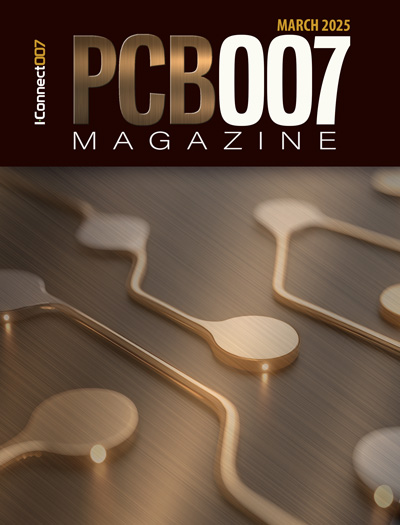-

- News
- Books
Featured Books
- pcb007 Magazine
Latest Issues
Current Issue
Voices of the Industry
We take the pulse of the PCB industry by sharing insights from leading fabricators and suppliers in this month's issue. We've gathered their thoughts on the new U.S. administration, spending, the war in Ukraine, and their most pressing needs. It’s an eye-opening and enlightening look behind the curtain.

The Essential Guide to Surface Finishes
We go back to basics this month with a recount of a little history, and look forward to addressing the many challenges that high density, high frequency, adhesion, SI, and corrosion concerns for harsh environments bring to the fore. We compare and contrast surface finishes by type and application, take a hard look at the many iterations of gold plating, and address palladium as a surface finish.

It's Show Time!
In this month’s issue of PCB007 Magazine we reimagine the possibilities featuring stories all about IPC APEX EXPO 2025—covering what to look forward to, and what you don’t want to miss.
- Articles
- Columns
Search Console
- Links
- Media kit
||| MENU - pcb007 Magazine
Flex Market Evolution
August 27, 2015 | Mike Morando, PFC Flexible CircuitsEstimated reading time: 2 minutes
Flex circuits are designed to solve electronic packaging and assembly problems, solve interconnection issues, assist in miniaturization, and provide a dynamic electro-mechanical solution. They are configured with repeatable conductors that foolproof assembly errors. Flex is used in designs where standard printed circuit boards, connectors and cable assemblies just don’t provide the right electrical or mechanical solution.
For solving standard types of solutions, flex vendors use off-the-shelf materials such as rolled annealed copper, Kapton®/polyimide and various adhesives. In some other applications, one can build rigid-flex, where FR-4, prepreg and solder-mask are added to get to the right mechanical construction. From a flex assembly perspective, thousands of 0201 (0.02”X 0.01”) and 0402 components are placed every day. These types of material constructions and component assemblies can be found in many flex circuit shops today.
But now flex vendors are seeing a new wave of challenges to solve. These challenges are rising out of the need for wearable electronics, higher speeds, mobility, component miniaturization, and overall electronic packaging density. Let’s take a look at some of these.
Density and Miniaturization
Two examples of new applications in the medical market that are driving flex technology are: 1) Remote_patient_monitoring, which is forecasted to grow at a 77% CAGR and 2) Wireless healthcare, which is forecasted to grow to $9.6 billion by 2018. Imagine wearing a device on your body that would connect wirelessly to the Internet and feed your doctor various bits of information about your body from your home. Or in this case, from your body, wherever it may be.
Medical devices and sensors are now wearable. We have multiple applications here at PFC today that are wearable solutions. Wearable applications require thinner materials, new circuit geometries, and miniature components. The wearable market is forcing components to be smaller, smarter, faster, and the packaging and assembly to become more complex.
To meet the needs of the medical market requirements standard, off-the-shelf, 1-ounce copper just won’t work. Flex materials are getting thinner, providing densities and flexibility increase. For example, new materials include a 12-micron (.00047 inches) adhesiveless material and there are discussions around 9-micron (.00035 inches) adhesiveless materials. These types of densities are required to meet flexibility, geometric and component requirements of the wearables market.
Because of the some of the new density requirements—lines, spaces and assembly/component placement—standard PCB suppliers and contract manufacturers cannot necessarily support the density of the components. Flex is now the answer. For example, a North American flex circuit supplier received a request from a product design company that is developing a wearable solution requiring a specific .4mm pitch BGA Bluetooth component. The designer’s “go-to” PCB supplier could not support the thickness/thinness requirements of the circuit. In addition, his go-to contract manufacturers could not place a .4mm pitch BGA Bluetooth component.
The Bluetooth component manufacturer suggested they work with the flex circuit supplier, since the supplier had placed the component for other projects. Remember, flex circuits have the ability of being almost any thickness, depending on chosen materials and electrical requirements. Flex is not bound by .031 or .062 standard thicknesses like PCBs.
The important fact here is that the design engineering firm is now using flex circuits instead of rigid PCBs, not because of the electro-mechnical characteristics of flex, but rather because flex can provide the thickness and package density required.
Mike Morando is VP of sales and marketing for PFC Flexible Circuits LTD.
Suggested Items
Indium’s Karthik Vijay to Present on Dual Alloy Solder Paste Systems at SMTA’s Electronics in Harsh Environments Conference
05/06/2025 | Indium CorporationIndium Corporation Technical Manager, Europe, Africa, and the Middle East Karthik Vijay will deliver a technical presentation on dual alloy solder paste systems at SMTA’s Electronics in Harsh Environments Conference, May 20-22 in Amsterdam, Netherlands.
SolderKing Achieves the Prestigious King’s Award for Enterprise in International Trade
05/06/2025 | SolderKingSolderKing Assembly Materials Ltd, a leading British manufacturer of high-performance soldering materials and consumables, has been honoured with a King’s Award for Enterprise, one of the UK’s most respected business honours.
Knocking Down the Bone Pile: Gold Mitigation for Class 2 Electronics
05/07/2025 | Nash Bell -- Column: Knocking Down the Bone PileIn electronic assemblies, the integrity of connections between components is paramount for ensuring reliability and performance. Gold embrittlement and dissolution are two critical phenomena that can compromise this integrity. Gold embrittlement occurs when gold diffuses into solder joints or alloys, resulting in mechanical brittleness and an increased susceptibility to cracking. Conversely, gold dissolution involves the melting away of gold into solder or metal matrices, potentially altering the electrical and mechanical properties of the joint.
'Chill Out' with TopLine’s President Martin Hart to Discuss Cold Electronics at SPWG 2025
05/02/2025 | TopLineBraided Solder Columns can withstand the rigors of deep space cold and cryogenic environments, and represent a robust new solution to challenges facing next generation large packages in electronics assembly.
BEST Inc. Reports Record Demand for EZReball BGA Reballing Process
05/01/2025 | BEST Inc.BEST Inc., a leader in electronic component services, is pleased to announce they are experiencing record demand for their EZReball™ BGA reballing process which greatly simplifies the reballing of ball grid array (BGA) and chip scale package (CSP) devices.


